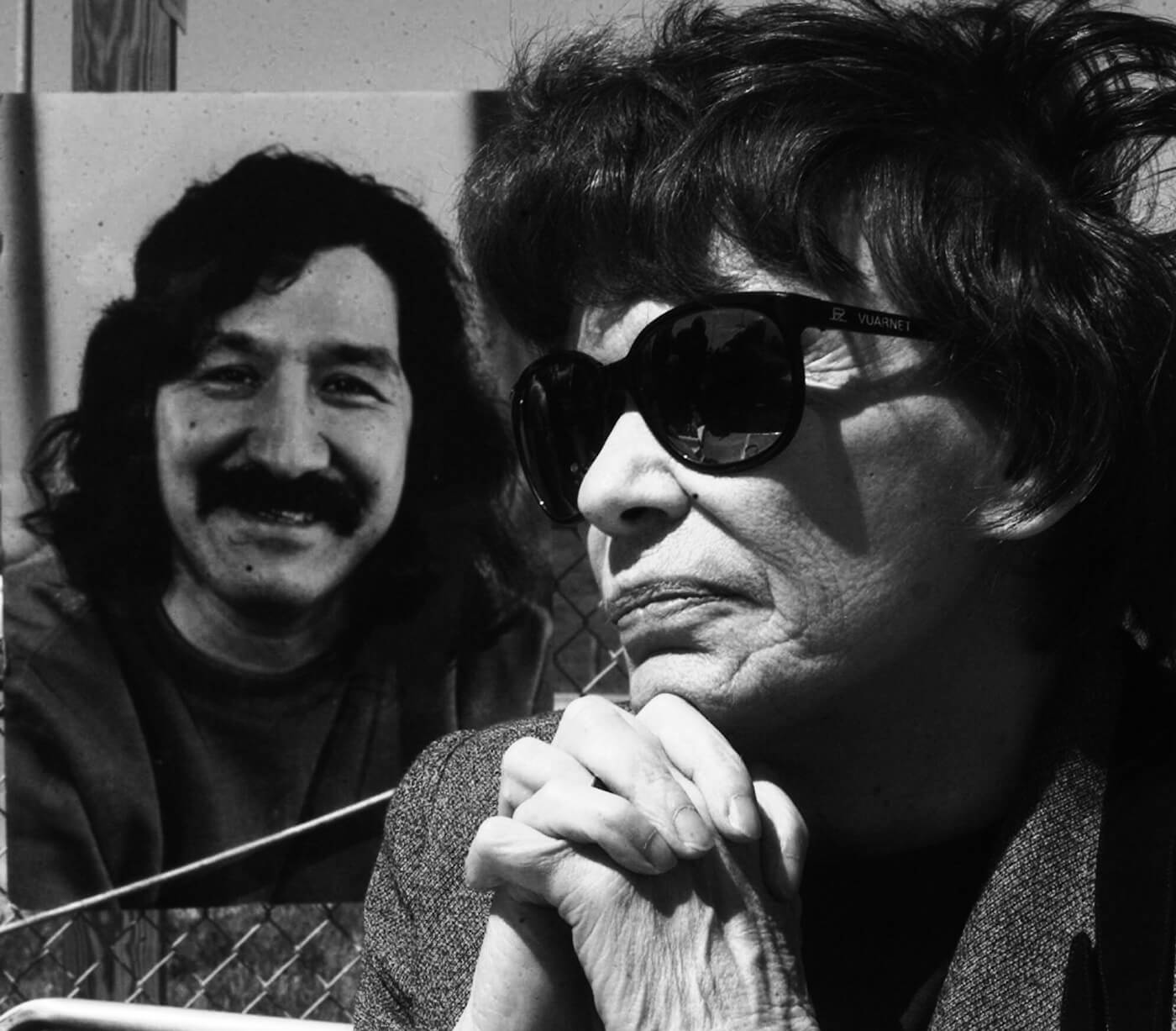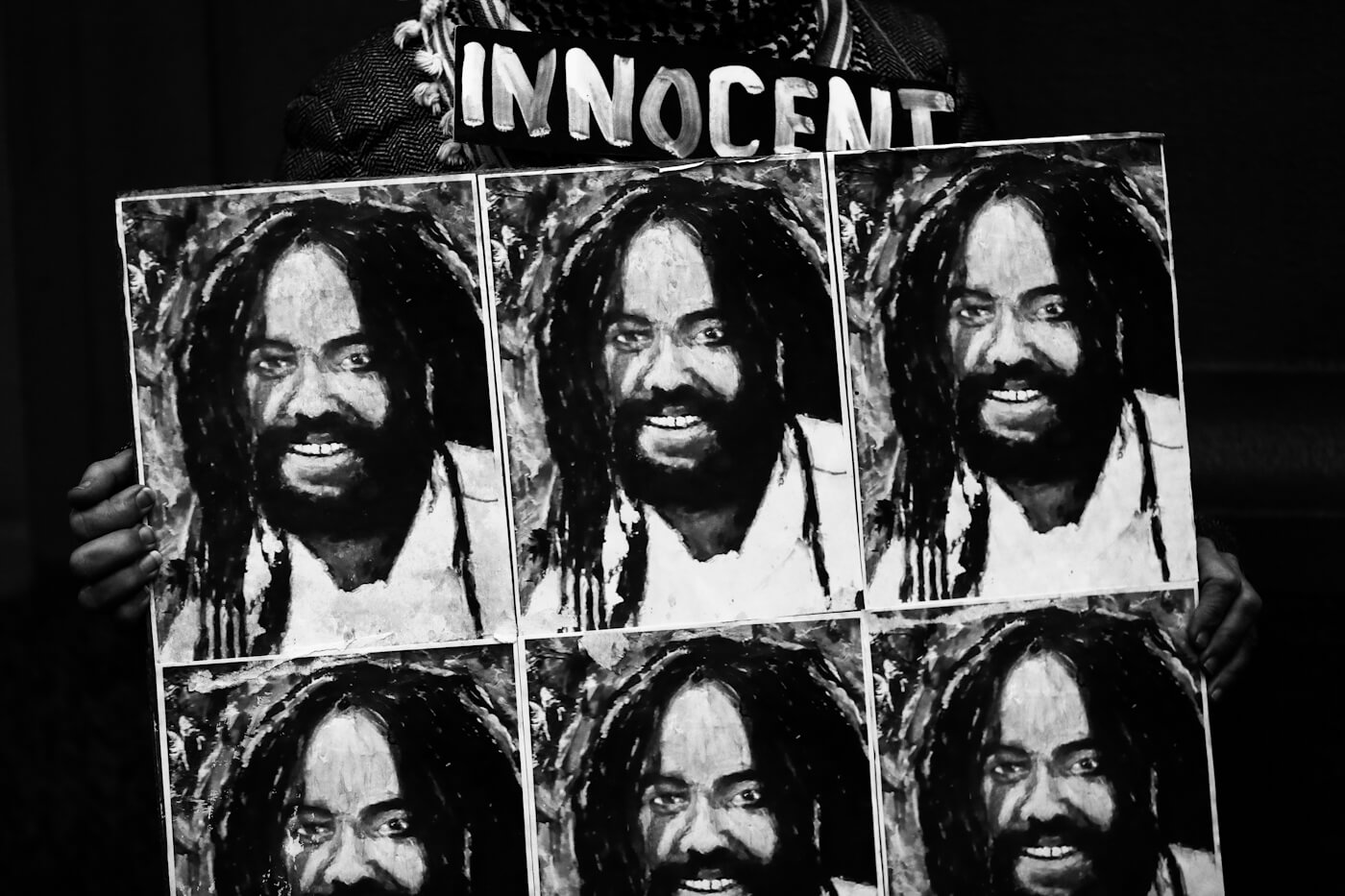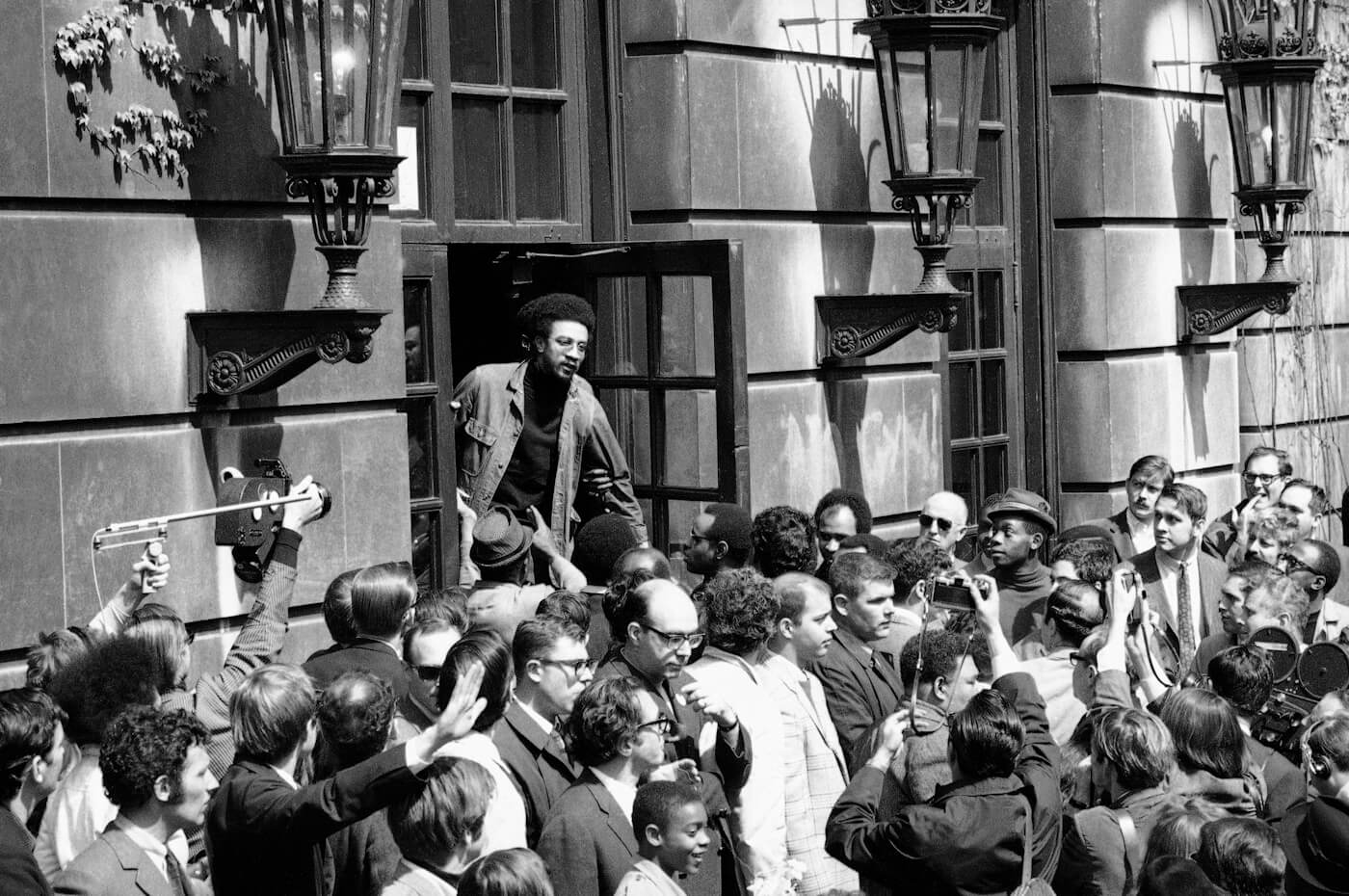When the history of our times is recorded, any volume on domestic political prisoners must, per force, begin with the legendary ones of conscience. To these icons of principle, determination and courage we owe much. It is, after all, not by mere default that they risked, and often paid, all to demand the gale of change sweep away generations of ignorance, hatred and greed that have long fed on communities of color and poverty, from coast to coast, in the United States. For them, it was never about the personal risk for they knew all too well the price that can be exacted for such integrity. For them, the alternative of silence was simply an option without a choice.
Leonard Peltier

Danielle Mitterrand, widow of former French president Francois Mitterrand, talks about her visit with Leonard Peltier near the U.S. Penitentiary at Leavenworth, Kan., April 30, 1999. Cliff Schiappa | AP
Leonard Peltier, a founder of the American Indian Movement, is now well into his fourth decade of imprisonment. Wrongfully charged and convicted for the defense of Wounded Knee against an FBI onslaught, his, more than any other continuing political persecution, lays bare the myth that the Department of Justice is committed to the pursuit of truth or equal application of law.
Having failed to secure a conviction in the first trial against his codefendants, at Peltier’s subsequent trial, the government recast, in its entirety, its storyline of what happened that fateful day during the firefight at the Pine Ridge Reservation between some 150 FBI agents, local law enforcement and vigilantes… and forty members of AIM.
At the first trial, in Cedar Rapids, Iowa, federal prosecutors argued that two FBI agents were essentially “murdered” during an exchange of gunshots with Native activists barricaded at an AIM compound located some distance away. Rejecting the assertion the agents were targeted, the jury acquitted the defendants on the basis of self defense.
After succeeding in moving the second trial to a more favorable government venue in Fargo North Dakota (long a hotbed of anti-Native animus and violence), federal prosecutor’s concocted a new strategy. Using a patchwork of evidence built of altered or suppressed testimony to remake a case already soundly rejected, prosecutors rewrote the script to now one where the agents were executed by close range gun shots to their heads. Because of this dramatic shift, Peltier was precluded from submitting any self-defense testimony. Inexplicably, the new judge also prevented the defense from establishing, at trial, that the FBI had a proven history… in Native prosecutions… of tampering with evidence and witnesses.
Unlike the first trial, where prosecutors introduced evidence that agents had been pursuing a red pickup truck before the shootout, this time they testified they were looking for an orange and white van… such as the one that Peltier had been seen using on occasion. Likewise, while an FBI ballistic expert testified that a shell casing recovered near the agents’ bodies matched a weapon tied to Peltier, prosecutors suppressed a different ballistic test which proved the casing could not have come from his gun. These changes were part of a conscious effort by government prosecutors to convert the trial… of this high profile political and human rights activist… from a search for truth to a staged performance in which it withheld more than 140,000 pages of discovery from the defense in its desperate drive to convict Peltier no matter what the truth or the cost.
Nowhere is the nature and extent of the government’s misconduct in the persecution of Leonard Peltier better summed up than it was by one of his appellate attorneys, former United States Attorney GeneralRamsey Clark, who branded the evidence used against him as “fabricated, circumstantial … misused, concealed, and perverted.” Different in tenor and tone, yet, essentially the same in conclusion, during one of Peltier’s appeals before the Eight Circuit his former prosecutor conceded “… we do not know who killed those agents. Further, we don’t know what participation, if any, Mr. Peltier had in it.”
Ultimately, this candid admission of a government frame proved worthless when Barack Obama denied Peltier’s request for a sentence commutation via cryptic email, on January 18, 2017, as he raced out the oval office no doubt to ready for his first book signing tour.
Next eligible for parole in 2024, when he is 79 years of age, Leonard Peltier, a Nobel Peace Prize nominee who is essentially wheel chair bound and suffers from a potential life threatening internal bleeding condition, is likely to die in prison.
Mumia Abu-Jamal

A protestor holds up a poster depicting Mumia Abu-Jamal during a demonstration outside the offices of District Attorney Larry Krasner, Dec. 28, 2018, in Philadelphia. Matt Slocum | AP
The thirst for vengeance is no less voracious in state court prosecutions that target political dissidents. Though state substantive offenses may vary and the rules of evidence change, prosecutors and judges still adhere to an age-old obedient oath that those who forcefully confront and expose institutional power and authority must be called to task… and damn the truth. While examples abound, no clearer one exists then the decades long political feed on Mumia Abu-Jamal.
Much has been written by and about Abu-Jamal and his journey, over the course of almost 40 years of imprisonment, largely spent on Pennsylvania’s death row, as an ever-present thorn in the veil of institutional isolation and secrecy that consumes its every prison bunk. And while, for some, debate continues over whether he pulled the trigger in the shooting death of a Philadelphia police officer, no such disagreement concerns his life as a community activist and full-time challenge to its notoriously corrupt police department and office of the District Attorney.
After his beating by white supremacists, as a mere teen, Mumia found his voice through the Black Panther Party, a chapter of which he helped to found in Philadelphia eventually becoming its “Lieutenant of Information” responsible for writing its policy positions and news releases.
Like many others, Mumia was targeted by the FBI COINTELPROprogram which in Philadelphia drew upon the cooperation of local police as they targeted community activists and dissidents. Across the country, black “radical” groups were infiltrated and disrupted with hundreds of their members physically attacked, falsely charged and imprisoned; more than a few the subject of outright government assassination.
Over the years, Mumia became a widely recognized and respected voice in alternative news while working at various local, and then national, outlets ranging from university radio stations to NPR… from which he was eventually fired because of his opinions. Ultimately, becoming the President of the Philadelphia Association of Black Journalists, whenever controversy arose, Mumia was sure to be found providing a platform for dissenting views otherwise silenced by the long seated powerful of Philadelphia.
Mumia was a relentless criticof the Philadelphia police department… often citing its documented history of excessive force and corruption including fabricating evidence. He was no less critical of Mayor Frank Rizzo, a former police commissioner, accusing him of fostering an environment rife with systemic racial bias and police brutality.
Nowhere is that more evident than in his damning criticism of the police department’s repeated confrontations with MOVE, the communal Black liberation movement that lived in West Philadelphia promoting a revolutionary ideology like that of the Black Panther Party.
Two major confrontations with the police, one an armed standoff which resulted in the death of an officer and another where a police helicopter dropped a bomb on the MOVE compound causing a fire that killed eleven of its members, including five children, and destroyed 65 neighborhood houses, best define the tension between a movement which Mumia at first supported, and then later joined, and the Philadelphia police.
Can it be mere happenstance that Abu-Jamal’s favorable reporting on behalf of the accused, during the trial of the “MOVE Nine” for the death of that officer, presaged his own arrest and prosecution for a like accusation not all that long thereafter?
While legal scholars continue to argue over the weight of evidence at Mumia’s trial, there can be no reasoned disagreement over the fact that it was a racially charged prosecution of a dynamic political dissident from the African American community of Philadelphia in 1982.
Indeed, in exercising eleven out of fourteen peremptory challenges to eliminate prospective black jurors, prosecutors ended up with a jury panel comprised of two blacks and ten whites, all but guaranteeing the trier of fact was tainted with racial bias even before it heard the first witness. Years later, any question about Abu-Jamal’s trial being fueled by racial hate was further evidenced by an affidavit of a courtstenographer who swore that she overheard the trial Judge, Albert Sabo, comment outside the courtroom, “…Yeah, and I’m going to help them fry the nigger.”
Against this light, the trial, itself, was replete with prosecutorial misconduct ranging from suppression of the confession of a man who said he was the actual shootertothe failure to call an eyewitness who told police Mumia was not the gunman. Later, he testified police tore up his original statement and coerced him into signing another one implicating Abu-Jamal. Other witnesses subsequently claimed they had seen another person fleeing from the scene of the shooting. Though this other person’s presence at the crime was known to prosecutors at the time of the trial, it was concealed from the jury. Forensic evidence connecting Mumia to the crime was no more reliable. For example, the coroner testified at trial that the bullet extracted from the deceased was a .38-caliber round which matched the weapon recovered from Mumia. At the time of the autopsy he noted in his official medical examiner records that it was a.44 caliber.
Just this past week, Abu-Jamal prevailed in his decades old battle to obtain justice when the current Philadelphia District Attorney withdrew his opposition to his de novo appeal based upon a conflict of interest by the former Pennsylvania Chief Justice, Ronald Castille, who oversaw Mumia’s state court appeals between 1998 and 2012. Castille, an avid supporter of the death penalty with close ties to police unions, had been Philadelphia’s District Attorney during the early years of Abu-Jamal’s attempt to overturn his conviction.
Leonard Peltier and Mumia Abu-Jamal are but two of the most prominent long-term political prisoners in the United States today. Meanwhile dozens of others now well into their sixties, seventies and older have also spent decades entombed in maximum security state and federal penitentiaries that crisscross the country.
H. Rap Brown

H. Rap Brown converses with the crowd, including journalists, outside the student-occupied Hamilton Hall on the campus of Columbia University in New York, April 26,1968. Photo | AP
To many, Rap Brown is a legendary figure synonymous with revolutionary movements that drove generations of activists in the 60’s, 70’s and 80’s to confront Jim Crow, the war in Vietnam and systemic class, race and gender based discrimination through militant action. Now 76 years of age, and known as Jamil Abdullah al-Amin, he sits in the United States Penitentiary in Tucson fighting cancer while doing a life sentence for a state court conviction for a murder that occurred some eighteen years ago. Like so many other prosecutions of high profile black leaders of his day, his is one beset by nagging questions.
Thus, the prosecutor’s theory that Abdullah al-Amin opened fire on police officers who came to arrest him for his mere failure to appear in court for a speeding ticket beggars the imagination. Given his long history as an iconic leader in the national African American community, his then success in local business and prominence as a Muslim preacher and community activist speaking out against drugs and gambling, this inexplicable act of gratuitous violence reeks of intent…looking for motive.
At trial, prosecutors argued al-Amin had failed to provide an alibi for his whereabouts at the time of the crime. Nor did he offer any explanation for fleeing the state after the shooting or account for why the weapons used in it were found near him at the time of his arrest.
Against this entirely circumstantial evidence, the defense established that al-Amin was not wounded during the shootout… as the surviving deputy had reported. That same officer described the killer’s eyes as grey… al-Amin’s are brown. Most important, another man, Otis Jackson, while incarcerated on another charge, confessed to the shooting well before the trial but the court did not allow his confession into evidence. That admission matched essential, and not publicly known, details from 911 calls following the shooting… including a report that a bleeding man was seen limping from the scene. Jackson said he knocked on doors attempting to obtain a ride while suffering from wounds that he had sustained during his firefight with deputies.
So Many More
Who among us today remembers the names let alone the history of Ruchell Magee or Álvaro Luna Hernández or Kamau Sadiki or Kojo Bomani Sababu or Bill Dunne or Joy Powell or Jalil Muntaqimor Russell Maroon Shoats or Edward Poindexter or Romaine Chip Fitzgerald or Joseph Bowen or Fred Burton or Janet Holloway or the other MOVE Nine who remain imprisoned years after evidence showed that the officer they were convicted of killing likely died of friendly fire. Each of these men and women has been imprisoned for decades; victims of a rush to judgment… of politics and prosecutions and passion all but blinded by the hate and fear of the day.
While movements such as the Black Panther Party, the BLA, AIM and MOVE still resonate among some in a new generation of activists, many of their former members, now riddled with poor health and buried in prison, have been all but lost to the passage of time as death can be a slow traveler.
Feature photo | Jamil Abdullah Al-Amin, known in the 1960s as H. Rap Brown, sits outside his Community Grocery store in Atlanta, July 4, 1990. Tami Chappell | AP
Stanley Cohen is a US-based attorney and human rights activist who has done extensive work in the Middle East and Africa.
This piece originally appeared on CounterPunch and was republished with special permission from the author.
The post Death Can be a Slow Traveler: Peltier, Mumia and Rap Brown appeared first on MintPress News.
